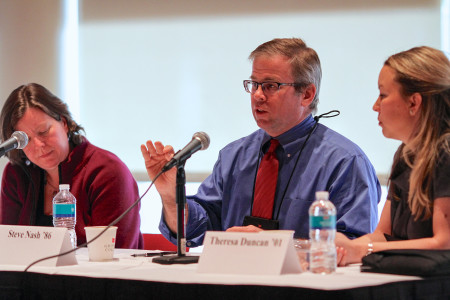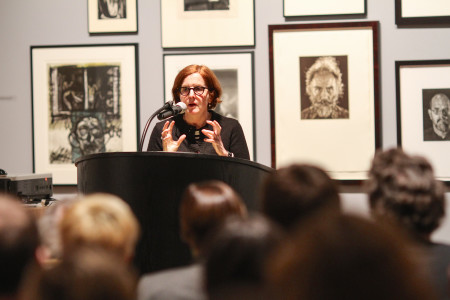
Photo by Aaron Juarez.
This past weekend, Grinnell invited alumni involved in the museum field to give a symposium entitled “Socially Responsive Museum Weekend.” Through panel discussions, returning alumni discussed the benefits and challenges of incorporating technology into museums, staying relevant and increasing diversity for both staff and visitors.
New York Times art critic Roberta Smith ’69 was one of the keynote speakers.
“… everything humans design has a degree of visual intelligence that it communicates—you can give it many names like beauty or usefulness or design, but it’s just that … a lot of things function fine, but they do very little to enhance our visual experience of life,” she said in Faulconer Gallery on Friday, Jan. 30.
Steve Nash ’86, Chairperson and Curator of Archaeology at the Denver Museum of Nature and Science, opened the first panel on Saturday with the controversial statement, “Digital preservation is an oxymoron,” to provoke conversation about one of the biggest difficulties he sees with adopting new museum technologies—planned obsolescence. In the past 20 years or so, museums have had to begin working with for-profit companies, rather than in-house tech developers, and the capitalist system of constantly updating products has proven financially difficult for most museums to keep up with, Nash said.
For-profit technology also has an inherent exclusivity to it—if the museum partners with an outside company to develop a smartphone app, then that information is only available to museums visitors who have smartphones, or else the museum has to invest in smartphones to be used by visitors. These smartphones will also likely be considered old and obsolete within just a few years. For these reasons, Nash said that museums try to be intelligently selective when adopting new technology into their exhibits.
“It should never be technology for the sake of technology, it must always be with the goal of improving engagement,” said Megan Bryant ’91, Director of Collections and Intellectual Property at The Sixth Floor Museum at Dealey Plaza, in Dallas, Texas.
In contrast, Theresa Duncan ’01, the Vice President for Development at the Aquarium of the Pacific in Long Beach, California, has found technology to be a great way to share information about animals that are too big, too small or too rare to be able to show in a live exhibit. During the panel discussion titled, “Can technology improve the museum experience?” she played a recording of a real whale call for the audience that is part of a sound-based project the aquarium recently created.

Photo by Aaron Juarez
“When you ask a visitor what their favorite experience is at the museum, it’s an authentic experience, it’s a touch experience,” Duncan said. “[With technology], you’re a step away from authenticity, but it’s the closest thing I think we can achieve in the museum world.”
As a leader in fundraising efforts, Duncan has found unexpected trends in raising funds for creative projects.
“What’s surprising to me from a fundraising perspective, is the bigger ideas attract the bigger dollars … I think people want to be part of something big—bigger than themselves, bigger than their family,” Duncan said. “When someone thinks about a large gift, they want it to be transformational.”
Often the bigger visions center around diversifying the visitors of a museum and bringing in young students from low-income families.
“That’s a very attractive thing for donors to fund, access programming for school kids,” said Alice Anderson ’04, Research and Evaluation Associate at the Science Museum of Minnesota.
Donor-sponsored school trips are just one of the many ways Smith wishes that more museums would begin working toward full accessibility for all. Smith believes that museums should do everything they can to eliminate admission fees, as they exclude such a large population from access to important artifacts of our cultures and history.
“I think they should see it as a fault or a burden that they should do everything they can to remove from the visitor. Because it is a barrier between the visitor and the art, and there shouldn’t be any barriers,” Smith said. “There are all sorts of ways you can approach it, but first they have to see it as … a great fault they should be trying to remedy. But I don’t think that’s the attitude in a lot of places. It is more than it was 20 years ago … Museums as a whole are more community-minded … trying to reach audiences they weren’t trying to reach before.”
One example is the weekly four free hours of admission to the Museum of Modern Art in New York, which is sponsored by Target. Other possibilities that museums have instituted include free admission for students or people under 19, one free day every week or “pay what you wish” days.
While many smaller museums rely on admission fees as a large percentage of their income, Trevor Jones ’94, the Director of Museum Collections and Exhibitions at the Kentucky Historical Society, argued for a way to significantly decrease spending—slimming down collections to artifacts that are truly valuable to the museum, which would save museums a lot in care costs for items in storage.
“Museums need to stop thinking about the number of artifacts they have, and more about the quality of the artifacts they have, and how they function with the mission and tell good stories,” Jones said.
Jones is one of the leading voices of “Active Collections,” an organization which encourages history museums to reevaluate all items in their collections and share with other museums or discard those items that do not act as an important piece of the story a museum is trying to tell.
“We believe that artifacts can be powerful tools—touchstones filled with meaning and connection—but only when used effectively,” the Active Collections manifesto reads. “We believe collections must either advance the mission or they must go.”
Although the alumni in attendance work in a wide variety of positions at science, historical and art museums of many sizes and affiliations, all expressed passionately their love of the commitment to people and education.
“I think we all have common missions in terms of serving the public, conserving objects and giving people experiences they can’t get in other, more formal learning environments,” Anderson said.























































